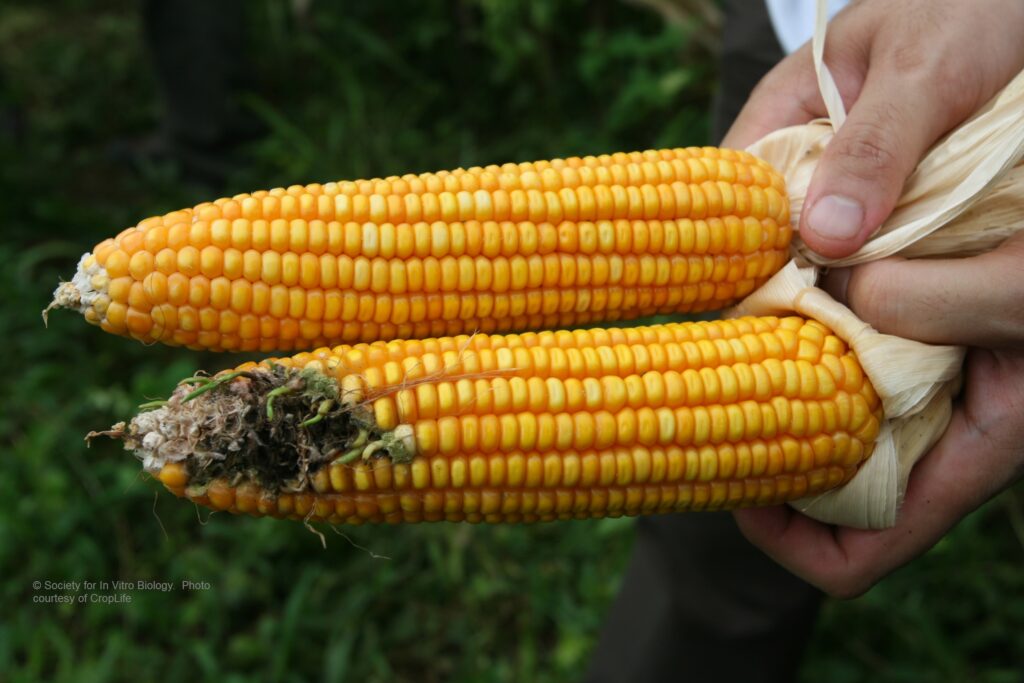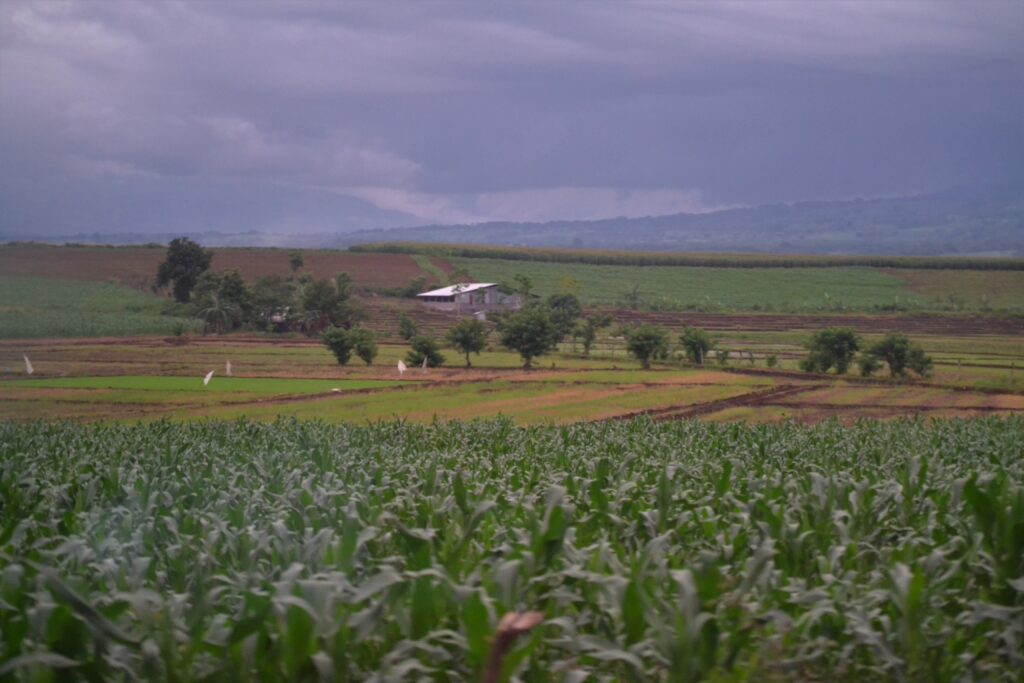Text and Photos by Henrylito D. Tacio
Additional Photo: BIOTECH
Corn is the country’s second staple food – after rice. The white variety is a common food in the tables of some provinces of Visayas and Mindanao.
The problem why some Filipinos don’t eat corn is due to the perception that only poor people eat corn. There are those who associate corn, especially the yellow variety, as animal feed.
About 2.5 million hectares in the country are planted to corn. About 1.3 million Filipinos are planting corn in their farms. Seventy percent of corn production is concentrated in Northern Luzon, Southern Mindanao, and Northern Mindanao.
“Corn growing varies depending on the area, and its production cycle is different in all parts of the world,” said statista.com.
“In the Philippines, corn production is based on the landscape and topography of the area,” statista.com added. “In 2020, the production volume of corn amounted to over eight million metric tons, higher than the produced quantity of 7.98 million metric tons in the previous year.”
Unfortunately, despite the abundance of corn production, the income of corn farmers didn’t increase.
What made corn farmers even more cautious was when the Department of Agriculture (DA) will lower tariffs on corn imports. Doing so would mean a “death sentence” to farmers, given the prevailing low price of corn.
“(The implementation will bring) revenue loss of P10 billion,” said House Resolution 2289, which Cagayan de Oro Representative Rufus Rodriguez filed. The resolution is supported by the Philippine Maize Federation, Inc. (Philmaize) and the United Broilers and Raisers Association (UBRA).
The resolution was directed as a petition to the National Economic Development Authority (NEDA) and the Tariff Commission.
Right now, the corn tariff is now low at 5% if importation is within the ASEAN Trade in Goods Agreement (ATIGA). It is slapped with a 35% duty within Minimum Access Volume (MAV) importation and 50% outside MAV.
The agriculture department just created a Technical Working Group to study lowering of corn import duties in order to bring down animal feeds and livestock and poultry prices.
Philmaize, however, has debunked the assumption that feed prices will go down given lower corn prices, consequently pulling down livestock and poultry prices.
“Philmaize stated that these corn prices do not have direct and immediate correlation to the decrease of feeds and meat price. In the last two years, corn prices plunged to P9-8 per kilo, but there was no reduction in the price of feed and meat,” the resolution said.
Rather, it is the huge importation of feed wheat and corn that caused the fall in local corn prices to its lowest level. Philmaize based its claim on a study conducted by the Philippine Competition Commission.
According to Philmaize, the fall of local corn prices are due to the uncontrolled, unabated, and uncalibrated large arrivals of feed wheat and imported corn during the wet season harvest.
“This displaced local corn harvest from getting into warehouses and silos of the livestock and feed mill sector,” Philmaize said.
As a result, corn prices plunged by a hefty 33% to P8-9 per kilo, far below the P13.25 per kilo support price established by the National Food Authority (NFA).
The economic loss of P10 billion in revenue experienced by farmers was exacerbated by the coronavirus disease 2019 (COVID-19) pandemic, which started in March 2020.
For its part, UBRA stressed that the price of poultry and livestock are “not dependent on the rate of corn tariffs but on the highly in-demand dynamics of the commodities,” to quote the words of its president, Jose Elias Enciong.
Even the Bayanihan sa Agrikultura admitted a low import duty on corn does not guarantee a significant reduction in the price of livestock and poultry.
The Rufus resolution cited the Magna Carta for Small Farmers in invoking the low corn tariff, saying it is the state’s role to assure “equitable distribution of benefits and opportunities realized through empowerment of small farmers.”
“The state should recognize the need to keep our local farmers motivated, encourage them to continue planting, and keep their production stable by implementing a more strategic approach to balance enterprise resource planning,” the resolution pointed out.
Instead of importing corn, some experts are suggesting that Filipino farmers should plant more Bt corn.
Bt corn is genetically modified corn. It was developed to resist the Asiatic corn borer (scientifically known as Ostrinia furnacalis), one of the most destructive corn pests. “The corn borer problem in the Philippines had a devastating effect on corn production,” said Dr. Rhodora Aldemita, director of the International Service for the Acquisition of Agri-biotech Applications (ISAAA). “The cost of corn went up because we had been importing.”
The Philippines is the first country in Southeast Asia to approve the commercial cultivation of a genetically modified crop – Bt corn – for feed and food.
There’s money in growing Bt corn.
Like his father before him, Ryan Lising is a corn farmer, and corn is his family’s main source of income. Corn gives him money not only to send his four children to school but also to help him expand his business and buy his own farm machinery. His crop also allows him to assist other corn farmers in their community.
But unlike his father, who planted white corn before him, Lising plants biotech corn (Bt corn), a crop that has made him an important person in their farming community of Mandani in Magalang, Pampanga.
Lising started planting biotech corn in 2003 after the government approved the commercial planting of Bt corn in the country.
Lising became one of the early adopters of Bt corn when it was introduced by seed company technicians. Though uncertain about the new corn that the technicians introduced in the farm demonstration, his frustrations with white corn – his crop then – urged him to try it.
Following his first Bt corn harvest, it became clear to Lising that there was no turning back. He knew that it was the beginning of a new life for him and his family, who has faced so many hardships in trying to make ends meet.
“When I realized that I will earn more if I plant Bt corn, I decided to add two more children to my brood. Sending my children to school was not that difficult anymore,” he said then.
When stacked traits corn was approved for commercial planting in the country, Lising did not hesitate to plant it on his farm, which has grown from 1.5 to more than 20 hectares.
It was a decision he never regretted.
After a decade of planting Bt corn, his life and that of his family have completely changed. His increased and steady income from planting Bt corn allowed him to explore other business opportunities.
“I have a new motorcycle now to replace the stolen one,” he admitted, “and I was able to buy my own farm machines. I have two trucks and two tractors, and I am getting a new, bigger tractor soon.”
Lising also has more time to spend with his family because he does not need to spend a lot of time on his farm. He also found other means of livelihood in their community.
From 10,769 hectares in 2013, the area planted to Bt corn has grown exponentially to 834,617 hectares in 2020.
The Philippines now ranked 13th among 24 countries planting the biotech crop in 2017. In Asia, Bt corn is also planted in China, Indonesia, Japan, Malaysia, South Korea, and Taiwan. Other countries planting the crop are the United States, Canada, Switzerland, and some parts of South America and Africa.



